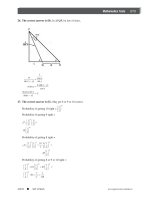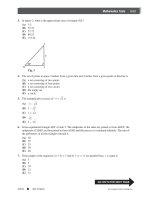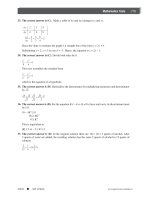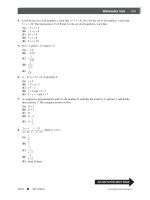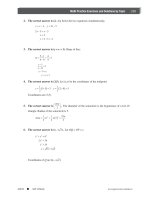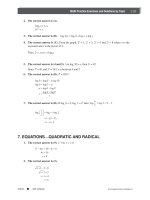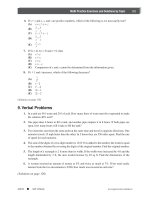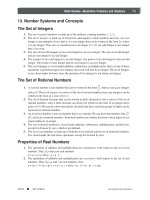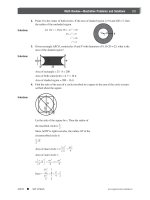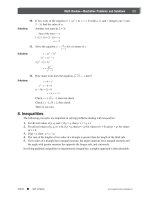SAT II Biology Episode 1 Part 1 pot
Bạn đang xem bản rút gọn của tài liệu. Xem và tải ngay bản đầy đủ của tài liệu tại đây (150.18 KB, 20 trang )
About The Thomson Corporation and Peterson’s
With revenues of US$7.2 billion, The Thomson Corporation (www.thomson.com) is a leading global provider of integrated
information solutions for business, education, and professional customers. Its Learning businesses and brands
(www.thomsonlearning.com) serve the needs of individuals, learning institutions, and corporations with products and
services for both traditional and distributed learning.
Peterson’s, part of The Thomson Corporation, is one of the nation’s most respected providers of lifelong learning online
resources, software, reference guides, and books. The Education Supersite
SM
at www.petersons.com—the Internet’s
most heavily traveled education resource—has searchable databases and interactive tools for contacting U.S accredited
institutions and programs. In addition, Peterson’s serves more than 105 million education consumers annually.
Editorial Development: American BookWorks Corporation
Contributing Editor: Barbara Maynard
For more information, contact Peterson’s, 2000 Lenox Drive, Lawrenceville, NJ 08648; 800-338-3282; or find us on the
World Wide Web at www.petersons.com/about.
COPYRIGHT © 2002 Peterson’s, a division of Thomson Learning, Inc.
Thomson Learning™ is a trademark used herein under license.
Previous editions © 2000, 2001
ALL RIGHTS RESERVED. No part of this work covered by the copyright herein may be reproduced or used in any form
or by any means—graphic, electronic, or mechanical, including photocopying, recording, taping, Web distribution, or
information storage and retrieval systems—without the prior written permission of the publisher.
For permission to use material from this text or product, contact us by
Phone: 800-730-2214
Fax: 800-730-2215
Web: www.thomsonrights.com
ISBN 0-7689-0907-4
Printed in the United States of America
10987654321 040302
CONTENTS
RED ALERT 1
About this Book 1
About the Test 2
SAT II Biology Study Plan 3
Panic Plan 6
Systems of Measurement 7
DIAGNOSTIC TEST 11
UNIT I—MOLECULES AND CELLS 33
Chapter 1: Chemistry—Atoms and Compounds 35
Chapter 2: Cells—Organization and Regulation 59
Chapter 3: Energy for Life—Anabolism and Catabolism 75
UNIT II—HEREDITY AND EVOLUTION 91
Chapter 4: Genetics—Mendel and Heredity 93
Chapter 5: Molecular Genetics—DNA and Evolution 115
UNIT III—ORGANISMS AND POPULATIONS 141
Chapter 6: Organisms and Populations 143
Chapter 7: Animals—Structure and Function 169
Chapter 8: Behavior and Ecology 197
Chapter 9: Laboratory 215
PRACTICE TEST 1 223
PRACTICE TEST 2 261
PRACTICE TEST 3 295
ANSWER SHEETS 327
iii
ABOUT THIS BOOK
Almost a quarter of a million students take SAT II Subject Tests
(previously known as the College Board Achievement Tests) every
year. Many colleges require SAT II Subject Test scores. The purpose
of these tests is to measure and demonstrate your knowledge and/or
skills in specific subjects and to test your ability to apply that
knowledge on each particular examination. The better your score is,
the better your application will look to the colleges of your choice.
If you’re reading this book, it’s likely that you are preparing for
one of the SAT II Biology exams. We have tried to make this a
“workable” book. In other words, the book is set up so that, regard-
less of the level exam you’re taking, you will be able to find the
material necessary to study and to take those tests that are most
applicable to your level.
Divided into sections, the book begins with a diagnostic biology
exam. The purpose of this diagnostic test is to help you get a handle
on what you know and what needs more work. Take this exam (and
all of the tests) under simulated exam conditions, if you can. What
this means is that you should find a quiet place in which to work, set
up a clock, and take the test without stopping. When you are
finished, take a break and then go back and check your answers.
Always reread those questions you got wrong, since sometimes an
error can come from merely misreading the question. Again, double-
check your answers, and if they’re still not clear, read the appropriate
section in the review material.
Once you’ve completed your Diagnostic Test, it’s time to move
on to the biology review section. Study the material carefully, but feel
free to skim those portions of the review section that are easiest for
you.
Then, take the Practice Tests. There are three simulated exams
designed to give you a broad spectrum of question-types, similar to
those you will find on the actual SAT II Biology test. We suggest that
regardless of whether you plan to take the E (ecological) or M
(molecular) version of the test, it would be extremely helpful to take
all of the tests in the book. In this way you will have a much broader
RED ALERT
RED ALERT
1
Peterson’s n SAT II
Success: Biology E/M www.petersons.com
perspective of the exam and may even surprise yourself as to how
much you actually know about each level.
As you complete each exam, take some time to review your
answers. We think you’ll find a marked improvement as you work
through the Diagnostic Test and complete all of the full-length
practice tests. Always take the time to check the review section for
clarification, and if you still don’t understand the material, go to your
teacher for help.
ABOUT THE TEST
The Biology E/M test contains 60 general biology questions followed
by 20 questions in each of the special sections: Biology E or Biology
M. You can select the area in which you feel most confident, and,
after completing the 60 core questions, you can then take either the
Ecological or Molecular sections. That selection can be made when
you take the test by filling in the appropriate code for the section you
wish to take. You cannot take both sections on the same test date.
The test covers the following areas.
Cellular and Molecular Biology — 12%
Ecology — 12%
Classical Genetics — 10%
Organismal Biology — 30%
Evolution and Diversity — 11%
Ecology/Evolution (Biology E Test) — 25%
Molecular/Evolution (Biology M Test) — 25%
In order to take this test and do well, you should have completed at
least a one-year course in biology. In addition, it would be helpful to
have also taken algebra, in order for you to understand basic algebraic
concepts. Since you will not be allowed to use a calculator while
taking this test, it is also important to have basic mathematical skills,
although the calculations you will encounter will be fairly simple. In
addition, you will encounter some questions utilizing the metric
system, so you should brush up on this topic.
TAKING THE TEST
Since you will have 60 minutes in which to complete the exam, it is
important that you pace yourself. One important item to remember is
to be thoroughly familiar with the directions for the tests so that you
don’t waste time trying to understand them once you’ve opened your
test booklet.
Work through the easy questions first. The faster you can
complete those questions, the more time you’ll have for those that
are more difficult. You may use your test book for scratch paper, but
RED ALERT
RED ALERT
2
Peterson’s n SAT II
Success: Biology E/Mwww.petersons.com
keep your answer sheet clean; since they are machine-readable, any
stray marks might be misconstrued as an answer.
The questions are all multiple choice, with five lettered choices.
As with any multiple-choice test, you should approach each question
by first trying to select the correct answer. If the answer is clear to
you, select it at once. If you’re unsure, the first technique is the
process of elimination. Try to cross off any answers that don’t seem
to make sense or that you know are completely wrong. This im-
proves your odds of guessing the correct answer. If, for example, you
can eliminate three choices, you have a 50/50 chance of guessing the
correct answer. Otherwise, if you can’t eliminate any choices, you
have only a 20 percent rather than a 50 percent chance of getting the
answer correct.
SCORING
While it’s not imperative that you completely understand how the
test is scored, since the process shouldn’t deter you from trying to do
your best, you are probably aware that the scores are reported on the
200–800 point range.
Each question answered correctly receives one point. You will
lose a fraction of a point for each wrong answer. However, you will
not lose points if you don’t answer a question. (Make sure that if you
skip any answers, the next question you answer is filled in on your
answer page in the correct space.) Thus, it makes sense to guess at
those questions that you don’t know, and of course, as with most
multiple-choice questions, you should use the process of elimination
to increase the odds of guessing correctly. The more choices you
eliminate, the better are your odds for choosing the correct answer.
SAT II BIOLOGY STUDY PLAN
The most important thing you should have when preparing for the
SAT II Biology exam is a plan. To start, you should estimate how
much time you have before the exam. If you have enough time to
prepare completely, you’ll be okay. If, however, you’re somewhat
short on time, this plan will be even more valuable for you. We offer
you these different study plans to help maximize your time and
studying. The first is a 9-Week Plan, which involves concentrated
studying and a focus on the practice test results. The second is the
more leisurely 18-Week Plan, one that’s favored by schools. Finally, if
time is running short, you should use the Panic Plan. We don’t want
you to panic, however—this plan is supposed to help you conquer
that panic and help you organize your studying so that you can get
the most out of your review work and still be as prepared as possible
when it is time to take the test.
RED ALERT
RED ALERT
3
Peterson’s n SAT II
Success: Biology E/M www.petersons.com
These plans are supposed to be flexible and are only sugges-
tions. Feel free to modify them to suit your needs and your own
study habits. But start immediately, because the more you study and
review, the better your results will be.
THE 9-WEEK PLAN—TWO LESSONS PER WEEK
Week 1
• Lesson 1—Diagnostic Test. The diagnostic SAT II Biology test is
designed to help you determine what you need to know and where
to focus your studying. Take this test under simulated test condi-
tions in a quiet room, and keep track of the time it takes to
complete the test. The diagnostic test has only 50 questions (30
general biology, 10 M-level, and 10 E-level). Regardless of which
specific test (E or M) you intend to take, you should answer all of
the questions on the diagnostic test to get an idea of the areas in
which you’re weakest.
• Lesson 2—Diagnostic Test Answers. Once you have completed
the test, spend this lesson carefully checking all of your answers
and reading through the explanations. This may take a bit of time,
but it will enable you to select those subject areas that you should
focus on and the areas on which you should spend the most
amount of time studying. Armed with this information, you can
start reviewing the chapters in the rest of the book.
Week 2
• Lesson 1—Chapter One: Chemistry—Atoms and Compounds.
Take your time to read through the first chapter. Note that the
style of the review material is in an outline format. It should be
similar to your classroom notes. Underline or use a marker to
highlight those areas that are unclear to you.
• Lesson 2—Chapter Two: Cells—Organization and Regulation.
Again, read through this chapter, mark whatever is unclear, and go
back and reread the material if necessary.
Week 3
• Lesson 1—Chapter Three: Energy for Life—Anabolism and
Catabolism. As you continue your lessons, try to study in a quiet
room, uninterrupted by others in your house or the TV, radio, or
any other noises.
• Lesson 2—Chapter Four: Genetics—Mendel and Heredity.
Again, read through this chapter, mark whatever is unclear, and go
back and reread the material if necessary.
RED ALERT
RED ALERT
4
Peterson’s n SAT II
Success: Biology E/Mwww.petersons.com
Week 4
• Lesson 1—Chapter Five: Molecular Genetics—DNA and
Evolution. You’re approaching the halfway point in the content
chapters of this book now, so continue reading and taking notes.
You can, of course, break these lessons into sections. Work on half
the chapter in the morning and the other half in the afternoon.
• Lesson 2—Chapter Six: Organisms and Populations. Read
through this chapter, mark whatever is unclear, and then go back
and reread the material if necessary. You can always ask your
teacher for additional information if you’re having difficulty.
Week 5
• Lesson 1—Chapter Seven: Animals—Structure and Function.
Chapters 7 and 8 are the last ones that cover the subject matter
that will be on the test. By now, you should have a strong under-
standing of the material.
• Lesson 2—Chapter Eight: Behavior and Ecology. This is the
final part of your journey into the subject review of SAT II Biology.
All that’s left is one more chapter that can help you improve your
scores on the actual exam.
Week 6
• Lesson 1—Chapter Nine: The Laboratory. While laboratory
exercises are not on the test itself, you must have a working
knowledge of lab techniques in order to do well on this exam. This
chapter will cover most of what you have already practiced in your
classroom.
• Lesson 2—Review. This is the time to take a breather and go back
and look over the content chapters of the book in order to find
anything that might have slipped by. Look at the illustrations. Do
you understand them? Try to answer some questions from earlier
chapters. How did you do? You still have some time before taking
the practice tests.
Week 7
• Lesson 1—Practice Test 1. Answer as many of the questions as
you can, and then guess at those you don’t know. Circle those
questions that you guessed at so you can zero in on those specific
answers and so you don’t delude yourself into thinking that you
really knew those answers in the first place. Answer the questions
in the General Biology section first, and then answer all of the
questions in each of the E and M portions of the exam. It’s
important to evaluate what you know.
• Lesson 2—Practice Test 1 Answers. Check all of your answers to
both parts of the test.
RED ALERT
RED ALERT
5
Peterson’s n SAT II
Success: Biology E/M www.petersons.com
Week 8
• Lesson 1—Practice Test 2. Take this test and answer as many of
the questions as you can. By now, you will have noticed how
much you have improved since you took the diagnostic test.
• Lesson 2—Practice Test 2 Answers. Check your answers to both
parts of the test.
Week 9
• Lesson 1—Practice Test 3. This is the final test. After taking this
test you will have answered 300 multiple-choice questions on these
three practice tests as well as 50 more on the diagnostic test.
Although there may be some new material on the actual test that
you haven’t encountered here, you should be very well prepared.
• Lesson 2—Practice Test 3 Answers. Check your answers to both
parts of the test, and then relax!
THE 18-WEEK PLAN—1 LESSON PER WEEK
If you’re lucky enough to have the extra time, the 18-Week Plan will
enable you to better utilize your study time. You will now be able to
spread out your plan into one lesson a week. This plan is ideal
because you are not under any pressure and you can take more time
to review the material in each of the chapters. You will also have
enough time to double-check the answers to those questions that
might have given you problems. Keep in mind that the basis for all
test success is practice, practice, practice.
THE PANIC PLAN
We hate using this term, and while we hope you don’t fall into this
category, not everyone has the luxury of extra time to prepare for the
SAT II Biology test. Perhaps, however, we can offer you a few helpful
hints to get you through this difficult and stressful period.
Read through the official SAT II Biology bulletin and this SAT II
Success: Biology book, and memorize the directions. One way of
saving time on any test is to be familiar with the directions so you
can maximize the time you have to work on the questions. On this
test, they’re pretty simple.
Read the introduction to this book. It will be helpful in prepar-
ing for the test and will give you an understanding of what you can
expect on the exam and how much time you will have to complete
both sections of the test.
Take the diagnostic test as well as the practice tests.
Focus whatever time you have left on those specific areas that
gave you the most difficulty when you took the practice tests.
RED ALERT
RED ALERT
6
Peterson’s n SAT II
Success: Biology E/Mwww.petersons.com
Whatever time you have before the exam, keep in mind that the
more you practice, the better you will do on the final exam.
Good luck!
SYSTEMS OF MEASUREMENT
Some of the questions you will encounter on the SAT II Biology E/M
test will involve measurements in both the English and the metric
systems. Following is a brief review of the material. We suggest you
review these few pages and answer the practice questions we’ve
provided before you take the diagnostic and practice tests or begin
studying the biology review chapters in this book.
THE ENGLISH SYSTEM
When taking the SAT II Biology exam, you will need to be able to
compute using both the English system of measurement and the
metric system. It may also be necessary for you to convert measure-
ments from one system to the other, but in such cases, you will be
given the appropriate conversion factors.
Make sure you have the following relationships within the
English system memorized:
Conversion Factors for Length
36 inches 5 3 feet 5 1 yard
12 inches 5 1 foot
5,280 feet 5 1,760 yards 5 1 mile
Conversion Factors for Volume
2 pints 5 1 quart
16 fluid ounces 5 1 pint
8 pints 5 4 quarts 5 1 gallon
Conversion Factors for Weight
16 ounces 5 1 pound
2,000 pounds 5 1 ton
These conversion factors enable you to change units within the
English system.
Examples
1. How many feet are in 5 miles?
5 miles × (5,280 feet/1 mile) 5 26,400 feet
RED ALERT
RED ALERT
7
Peterson’s n SAT II
Success: Biology E/M www.petersons.com
Notice how the unit of “miles” cancels out of the numerator and
denominator.
2. How many ounces are in 2 tons?
2 tons × (2,000 pounds/1 ton) × (16 ounces/1 pound) 5
64,000 ounces
Notice how the units of “tons” and “pounds” cancel out of the
numerator and denominator.
THE METRIC SYSTEM
In the metric system, distance or length is measured in meters.
Similarly, volume is measured in liters, and mass is measured in
grams. The prefixes below are appended to the beginning of these
basic units to indicate other units of measure with sizes equal to each
basic unit multiplied or divided by powers of 10.
giga510
9
mega510
6
kilo510
3
hecto510
2
deka510
1
deci510
−1
centi510
−2
milli510
−3
micro510
−6
nano510
−9
pico510
−12
From the table above, we can see, for example, that a kilometer is
1,000 times as long as a meter, 100,000 times as long as a centimeter,
and 1,000,000 times as a long as a millimeter. Similarly, a centigram is
1
100
the size of a gram.
Conversions among metric units can be made quickly by moving
decimal points.
Examples
1. Convert 9.43 kilometers to meters.
Since meters are smaller than kilometers, our answer will be
larger than 9.43. There are 1,000 meters in a kilometer, so we
move the decimal point three places over to the right. 9.43
kilometers is equal to 9,430 meters.
RED ALERT
RED ALERT
8
Peterson’s n SAT II
Success: Biology E/Mwww.petersons.com
2. Convert 512 grams to kilograms.
Since kilograms are more massive than grams, our answer must
be less than 512. There are 10
−3
kilograms in a gram, so we
move the decimal point three places to the left. 512 grams are
equal to .512 kilograms.
CONVERSIONS BETWEEN THE ENGLISH AND THE METRIC SYSTEMS
Conversions between the English and metric systems are accom-
plished in the same way as conversions within the English system.
Recall that any problem that requires you to make such a conversion
will include the necessary conversion factors.
Examples
1. If 1 meter is equivalent to 1.09 yards, how many yards are in 10
meters?
10 meters × (1.09 yards/1 meter) 5 10.9 yards
2. If 1 yard is equivalent to .914 meters, how many meters are
there in 24 yards?
24 yards × (.914 meters/1 yard) 5 21.936 meters
SYSTEMS OF MEASUREMENT PROBLEMS
1. Express 38 meters in millimeters.
2. Express 871 millimeters in centimeters.
3. Which measurement is greater, 8,000 millimeters or 7 meters?
4. Arrange the following from smallest to biggest: 6,700 meters,
672,000 centimeters, and 6.6 kilometers.
5. Express 49 milligrams in centigrams.
6. 4.6 liters is how many milliliters?
7. A package weighing 32.5 kilograms is shipped to the U.S. What
is its weight in pounds? There are 2.2 pounds in a kilogram.
8. A line drawn on a blueprint measures 1.5 yards. What is its
length in meters? There are .914 meters in a yard.
9. If the distance between two exits on a highway is 40 kilometers,
what is the distance in miles? There are .62 miles in a kilometer.
10. A particular brand of bottled water is available in two different
bottle sizes—a 2.25 quart bottle and a 2.1 liter bottle. Which
bottle contains more water? There are 1.06 quarts in a liter.
RED ALERT
RED ALERT
9
Peterson’s n SAT II
Success: Biology E/M www.petersons.com
SOLUTIONS
1. Since meters are larger than millimeters, our answer will be
larger than 38. There are 1,000 millimeters in a meter, so we
move the decimal point three places over to the right. 38 meters
is equal to 38,000 millimeters.
2. Since millimeters are smaller than centimeters, our answer will
be smaller than 871. There are 10 millimeters in a centimeter, so
we move the decimal point one place over to the left. 871
millimeters is equal to 87.1 centimeters.
3. In order to answer this question, we must express both measures
in the same units. Since, for example, 8,000 millimeters is equal
to 8 meters, we can see that 8,000 millimeters is larger than 7
meters.
4. Let’s start by expressing all measurements in meters.
672,000 centimeters56,720 meters
6.6 kilometers56,600 meters
6,700 meters56,700 meters
Thus, from smallest to largest, we have 6.6 kilometers, 6,700
meters, and 672,000 centimeters.
5. Since there are 10 milligrams in a centigram, 49 milligrams is
equal to 4.9 centigrams.
6. Since there are 1,000 milliliters in a liter, there are 4,600 millili-
ters in 4.6 liters.
7. 32.5 kgs 5 32.5 kgs × (2.2 lbs/1 kg) 5 71.5 lbs
8. 1.5 yards 5 1.5 yards × (.914 meters/1 yard) 5 1.371 meters
9. 40 kilometers 5 40 kilometers × (.62 miles/1 kilometer) 5 24.8
miles
10. Express 2.1 liters in quarts.
2.1 liters 5 2.1 liters × (1.06 quarts/1 liter) 5 2.226 quarts. Thus,
the quart bottle holds more.
RED ALERT
RED ALERT
10
Peterson’s n SAT II
Success: Biology E/Mwww.petersons.com
DIAGNOSTIC TEST
While you have taken many standardized tests and know to blacken completely the ovals on the
answer sheets and to erase completely any errors, the instructions for the SAT II exam in Biology
differs from the directions for other standardized tests you have taken. You need to indicate on the
answer key whether you are taking the SAT II Biology with Ecological Emphasis (Biology-E) or
Molecular Emphasis (Biology-M).
The instructions on the answer sheet will tell you to fill out the top portion of the answer sheet
exactly as shown.
1. Print BIOLOGY-E or BIOLOGY-M on the line to the right under the words Subject Test
(print).
2. In the shaded box labeled Test Code fill in four ovals:
For BIOLOGY-E
—Fill in oval 1 in the row labeled V.
—Fill in oval 9 in the row labeled W.
—Fill in oval 4 in the row labeled X.
—Fill in oval B in the row labeled Y.
—Leave the ovals in row Q blank.
For BIOLOGY-M
—Fill in oval 1 in the row labeled V.
—Fill in oval 9 in the row labeled W.
—Fill in oval 4 in the row labeled X.
—Fill in oval B in the row labeled Y.
—Leave the ovals in row Q blank.
3. When everyone has completed filling in this portion of the answer sheet, the supervisor will
tell you to turn the page and begin. The answer sheet has 100 numbered ovals on the sheet,
but there are only 90 (or 95) multiple-choice questions in the test, so be sure to use only
ovals 1 to 90 (or 95) to record your answers.
Test Code
V
Þ ÞO
2
ÞO
3
ÞO
4
ÞO
5
ÞO
6
ÞO
7
ÞO
8
ÞO
9
W ÞO
1
ÞO
2
ÞO
3
ÞO
4
ÞO
5
ÞO
6
ÞO
7
ÞO
8
Þ
X ÞO
1
ÞO
2
ÞO
3
Þ ÞO
5
Y ÞO
A
Þ ÞO
C
ÞO
D
ÞO
E
Q ÞO
1
ÞO
2
ÞO
3
ÞO
4
ÞO
5
ÞO
6
ÞO
7
ÞO
8
ÞO
9
Subject Test (print)
BIOLOGY-E
Test Code
V
Þ ÞO
2
ÞO
3
ÞO
4
ÞO
5
ÞO
6
ÞO
7
ÞO
8
ÞO
9
W ÞO
1
ÞO
2
ÞO
3
ÞO
4
ÞO
5
ÞO
6
ÞO
7
ÞO
8
Þ
X ÞO
1
ÞO
2
ÞO
3
Þ ÞO
5
Y ÞO
A
Þ ÞO
C
ÞO
D
ÞO
E
Q ÞO
1
ÞO
2
ÞO
3
ÞO
4
ÞO
5
ÞO
6
ÞO
7
ÞO
8
ÞO
9
Subject Test (print)
BIOLOGY-M
11
Peterson’s n SAT II
Success: Biology E/M www.petersons.com
Directions: Each of the questions or statements below is accompanied by five choices. For each
question, select the best of the answer choices given.
1. Which of the following statements about
mitochondria is NOT correct?
(A) They serve as sites for cellular respira-
tion.
(B) They are enclosed by a double mem-
brane.
(C) They are the sites where most of the
cell’s ATP is produced.
(D) They are found in animal cells only;
plant cells have chloroplasts instead.
(E) They are found in eukaryotic cells but
not in prokaryotic cells.
2. Which of the following statements about
cell structure is NOT correct?
(A) Plant cells have cell walls, whereas
animal cells do not.
(B) Ribosomes are the main sites of energy
production for the cell.
(C) Plant cells have chloroplasts, whereas
animal cells do not.
(D) Lysosomes function in the digestion of
cellular waste products.
(E) Many cellular organelles are inter-
related through an endomembrane
system.
3. What would happen to a human red blood
cell if it was placed in distilled water?
(A) It would shrivel.
(B) It would plasmolyze.
(C) It would lyse.
(D) It would dehydrate.
(E) It would not be affected.
4. Which of the following pairs does NOT
represent a correct relationship?
(A) fat; lipid
(B) starch; polysaccharide
(C) starch; carbohydrate
(D) sugar; carbohydrate
(E) enzyme; lipid
5. Which of the following statements is
correct?
(A) The product of transcription is DNA.
(B) The product of transcription is mRNA.
(C) The product of transcription is a
polypeptide.
(D) The product of translation is mRNA.
(E) The product of translation is DNA.
➡
GO ON TO THE NEXT PAGE
DIAGNOSTIC TEST
DIAGNOSTIC TEST—Continued
13
Peterson’s n SAT II
Success: Biology E/M www.petersons.com
6. Which of the following is responsible for
changes in the Earth’s seasons?
(A) The tilt of the Earth’s axis toward or
away from the sun.
(B) The distance between the Earth and the
sun at different times of the year.
(C) The movement of the oceans’ currents.
(D) The annual cycles of temperature and
rainfall.
(E) The variation in the amount of energy
released by the sun from month to
month.
7. The two fundamental processes that govern
the dynamics of an ecosystem are
(A) solar radiation and the carbon cycle.
(B) photosynthesis and respiration.
(C) the carbon cycle and photosynthesis.
(D) energy flow and chemical/nutrient
cycling.
(E) the nitrogen cycle and the phosphorous
cycle.
8. A host plant produces a toxin that is lethal
to aphids feeding on its leaves. Over time,
some of the aphids become immune to the
toxin. In response, the host plant begins to
produce a different toxin that is lethal to
aphids. This is an example of
(A) parasitism.
(B) commensalism.
(C) predation.
(D) mutualism.
(E) coevolution.
9. The use of specially bred strains of bacteria
to clean up oil spills along beaches is an
example of
(A) primary succession.
(B) bioremediation.
(C) decomposition.
(D) coevolution.
(E) eutrophication.
10. In the food chain illustrated below, which
trophic level is represented by the earth-
worm?
sunflower — caterpillar —bluejay — tom
cat — earthworm
(A) primary consumer
(B) secondary consumer
(C) tertiary consumer
(D) quaternary consumer
(E) decomposer
11. Which of the following statements about
meiosis is correct?
(A) The result of meiosis is a zygote.
(B) Only somatic cells undergo meiosis.
(C) Meiosis restores the original diploid
condition of a population.
(D) Meiosis typically results in genetic
variation among the gametes produced.
(E) The products of meiosis are always four
cells identical to the parent cell.
DIAGNOSTIC TEST
DIAGNOSTIC TEST—Continued
14
Peterson’s n SAT II
Success: Biology E/Mwww.petersons.com
12. An animal organism with a diploid number
of chromosomes equal to 30 would
normally
(A) not be able to undergo meiosis because
gametes would end up with an odd
number of chromosomes.
(B) produce two gametes with 30 chromo-
somes each during meiosis.
(C) produce four gametes with 30 chromo-
somes each during meiosis.
(D) produce two gametes with 15 chromo-
somes each during meiosis.
(E) produce four gametes with 15 chromo-
somes each during meiosis.
Questions 13–14 r efer to the following
breeding experiment. The researcher’s goal
was to develop white mice with short tails.
P brown mice
with short tails
x white mice with long tails
F
1
all offspring are
brown and have
long tails
F
2
292 mice are brown with long tails
97 mice are brown with short tails
103 mice are white with long tails
36 mice are white with short tails
13. The results of the above cross indicate that
among the original parents (P-generation)
(A) both were heterozygous for coat color
and tail length.
(B) one was homozygous dominant for coat
color and tail length, whereas the other
was homozygous recessive for both
traits.
(C) one was homozygous dominant for coat
color and homozygous recessive for tail
length, whereas the other was homozy-
gous recessive for coat color and
homozygous dominant for tail length.
(D) one was homozygous dominant for
both traits, whereas the other was
heterozygous for both traits.
(E) one was homozygous recessive for both
traits, whereas the other was heterozy-
gous for both traits.
14. Based on the results, how many genes
control the four traits observed among the
F
2
progeny (brown coat color, white coat
color, short tail, long tail)?
(A) one
(B) two
(C) four
(D) eight
(E) sixteen
➡
GO ON TO THE NEXT PAGE
DIAGNOSTIC TEST
DIAGNOSTIC TEST—Continued
15
Peterson’s n SAT II
Success: Biology E/M www.petersons.com
15. A cooperative unit of many cells with
similar form and function is known as a(n)
(A) tissue.
(B) tissue system.
(C) organ.
(D) organ system.
(E) cell system.
16. Which of the following is NOT one of the
stages involved in the processing of food?
(A) ingestion
(B) digestion
(C) acid processing
(D) absorption
(E) elimination
17. Which of the following statements best
describes the process of gas exchange in
living organisms?
(A) Plants take in oxygen and give off
carbon dioxide during photosynthesis.
(B) Animals take in carbon dioxide and give
off oxygen during respiration.
(C) Animals take in oxygen and give off
carbon dioxide during respiration.
(D) Aquatic organisms cannot undergo gas
exchange with their environment.
(E) True gas exchange only occurs in
organisms with lungs.
18. Homeostasis refers to
(A) an animal maintaining a home range.
(B) a population maintaining a constant
population size.
(C) females remaining in their parents’
territory.
(D) plants ceasing to grow at a maximum
height.
(E) maintaining a steady state of internal
conditions.
19. The human skin contains all of the follow-
ing receptors EXCEPT
(A) pain receptors.
(B) pressure receptors.
(C) thermoreceptors.
(D) chemoreceptors.
(E) touch receptors.
DIAGNOSTIC TEST
DIAGNOSTIC TEST—Continued
16
Peterson’s n SAT II
Success: Biology E/Mwww.petersons.com
